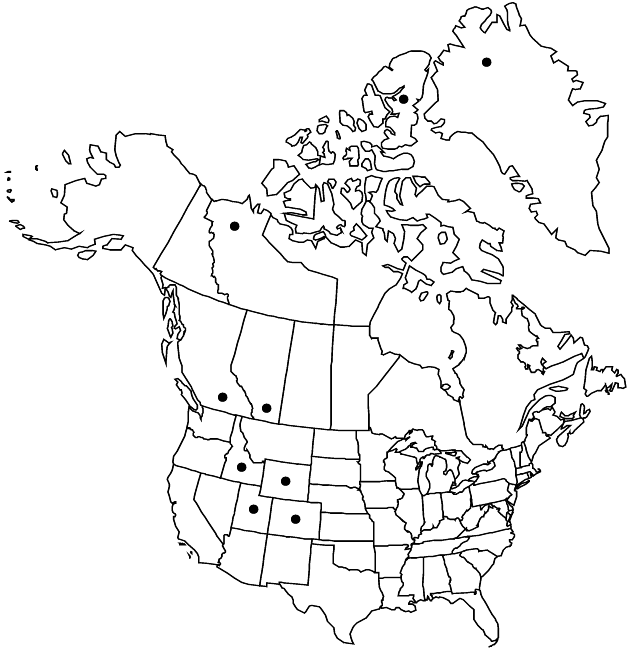Taraxacum scopulorum
Mem. New York Bot. Gard. 1: 455. 1900.
Plants 1–5 cm; taproots branched. Stems 1–3 (–5), ascending to erect, reddish or purplish, glabrous. Leaves fewer than 10, horizontal; petioles ± narrowly winged; blades linear-oblanceolate to narrowly oblanceolate (usually runcinate), (1–) 1.5–4 × 0.5–1 cm, bases attenuate, margins lobed regularly, deeply, in 3–5 (–7) pairs (occasionally dentate, rarely entire or subentire), lobes triangular, straight or often retrorse (also teeth), acute to acuminate or obtuse, teeth 0 or occasionally 1–3 on lobes (or replacing lobes), apices acuminate, faces glabrous or sparsely arachnoid-villous (particularly young). Calyculi (6–) 8–10, appressed to spreading, soon reflexed or revolute (thinner than phyllaries), pruinose, sometimes purplish (particularly adaxially), narrowly to broadly ovate bractlets in (1–) 2 series, 2.5–3.8 × 1.8–2.6 mm, margins not to ± scarious proximally, apices acuminate to broadly, shortly caudate, hornless, not callous, tips slightly scarious (purple), entire or slightly erose. Involucres dark to blackish green, pruinose, sometimes purplish, narrowly campanulate to cylindro-campanulate or cylindric, (6–) 10–12 (–14) mm. Phyllaries 8–12 in 2 series, lanceolate (outer) to ovate (inner), 1.5–3.1 mm wide, margins not scarious (outer) or broadly so, narrowing in distal 1/2 (green zone often darker marginally), apices acuminate, hornless, not callous, entire or tips slightly scarious-erose. Florets (ca. 15–) 35–50; corollas yellow (sometimes gray-striped abaxially), 7.5–8.8 × 1.3–2 mm. Cypselae pale reddish-brown or reddish-tinged or straw-colored to dark gray, bodies oblanceoloid, 2.8–3.5 mm, cones conic, 0.5–0.6 mm, beaks stout, 2.8–4.5, ribs 7 (wide) to 14 narrow (3–5 prominent), faces proximally smooth to tuberculate, muricate in distal 1/2; pappi white, 4.8–5.5 mm. 2n = 16? (as pumilum).
Phenology: Flowering summer.
Habitat: Dry to moderately drained areas, gravel, sand, silt, clay, with low organic content, ridges, arctic seashores, barrens, flood plains, high alpine tundra (south)
Elevation: 40–3400 m
Distribution

Greenland, Alta., B.C., N.W.T., Nunavut, Colo., Idaho, Utah, Wyo.
Discussion
Taraxacum scopulorum is known from the western Canadian Arctic Archipelago and from high-alpine summits in the western Cordilleras. This small species is characterized by lobed leaves, yellow ligules, and cypselae that are paler and less muricate than those of T. phymatocarpum.
The name Taraxacum lyratum Ledebour has been used for this species since the work of H. Handel-Mazzetti (1907), who annotated the type of T. scopulorum (GH). That type originated from the mountains of central Asia, and in his monograph Handel-Mazzetti included Kamchatka and northern Alaska in its range; I have not seen specimens of the species from Alaska. Also, his concept of T. lyratum seems to include heterogeneous elements, notably what is called here T. alaskanum. At the present time, I prefer to treat this species as restricted to North America, where the name T. scopulorum clearly applies to this very distinct, diminutive dandelion. It appears to be closely related to T. phymatocarpum, but the latter has mostly entire or slightly dentate leaves (some leaves sometimes slightly deltate-lobed), as opposed to the wholly deltate-lobed ones of T. scopulorum. A. E. Porsild (1957) illustrated this species under the name T. pumilum.
Selected References
None.
Lower Taxa
"fine" is not a number.
